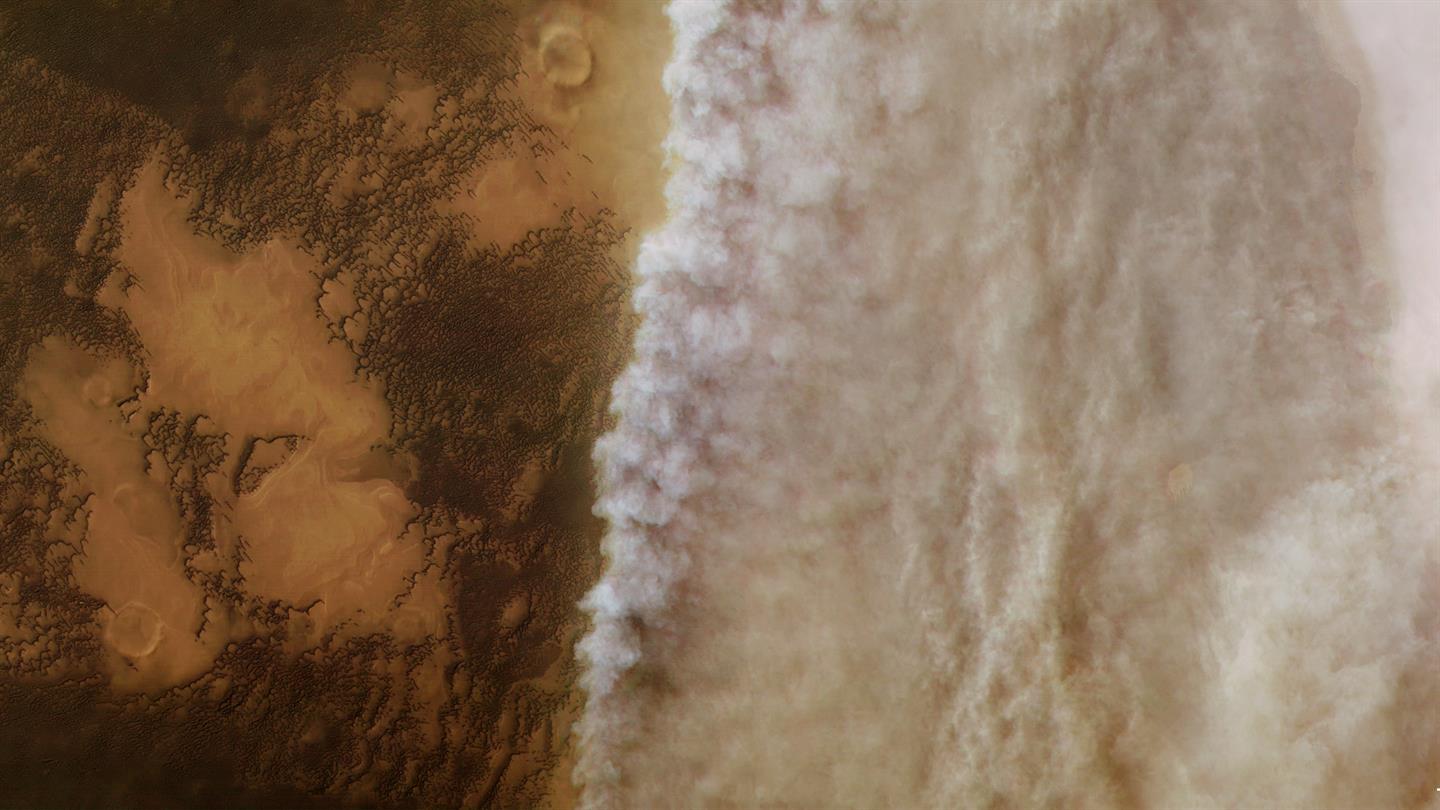The weather patterns on Mars are rather fascinating, owing to their particular similarities and differences with those of Earth. For one, the Red Planet experiences
dust storms
that are not dissimilar to storms that happen regularly here on Earth. Due to the lower atmospheric pressure, these storms are much less powerful than hurricanes on Earth, but can grow so large that they cover half the planet.
Recently, the ESA's
*Mars Express*
orbiter
captured images
of the towering cloud front of a dust storm located close to Mars' northern polar region. This storm, which began in April 2018, took place in the region known as Utopia Planitia, close to the ice cap at the Martian North Pole. It is one of several that have been observed on Mars in recent months, one which is the most severe to take place in years.
The images (shown above and below) were created using data acquired by the
Mars Express
'
High Resolution Stereo Camera (HRSC)
. The camera system is operated by the
German Aerospace Center
(DLR), and managed to capture images of this storm front - which would prove to be the harbinger of the Martian storm season - on April 3rd, 2018, during its 18,039th orbit of Mars.
[caption id="attachment_139647" align="aligncenter" width="580"]
Anaglyph 3D image of the dust storm front forming above the subpolar plains in northern Mars. Credit: Credits: ESA/DLR/FU Berlin
[/caption]
This storm was one of several small-scale dust storms that have been observered in recent months on Mars. A much larger storm emerged further southwest in the Arabia Terra region, which began in May of 2018 and developed into a
planet-wide dust storm within several weeks
.
Dust storms occur on Mars when the southern hemisphere experiences summer, which coincides with the planet being closer to the Sun in its elliptical orbit. Due to increased temperatures, dust particles are lifted higher into the atmosphere, creating more wind. The resulting wind kicks up yet more dust, creating a feedback loop that NASA scientists are still trying to understand.
Since the southern polar region is pointed towards the Sun in the summer, carbon dioxide frozen in the polar cap evaporates. This has the effect of thickening the atmosphere and increases surface pressure, which enhances the storms by helping to suspend dust particles in the air. Though they are common and can begin suddenly, Martian dust storms typically stay localized and last only a few weeks.
While local and regional dust storms are frequent, only a few of them develop into global phenomena. These storms only occur every three to four Martian years (the equivalent of approximately 6 to 8 Earth years) and can persist for several months. Such storms have been viewed many times in the past by missions like
Mariner 9
(1971),
Viking I
(1971) and the
*Mars Global Surveyor*
(2001).
[caption id="attachment_139453" align="aligncenter" width="580"]
This global map of Mars shows a growing dust storm as of June 6, 2018. The map was produced by the Mars Color Imager (MARCI) camera on NASA's Mars Reconnaissance Orbiter spacecraft. The blue dot indicates the approximate location of Opportunity. Image Credit: NASA/JPL-Caltech/MSSS
[/caption]
In
2007
, a large storm covered the planet and darkened the skies over where the Opportunity rover was stationed - which led to two weeks of minimal operations and no communications. The most recent storm, which began back in May, has been less intense, but managed to create a state of perpetual night over
Opportunity's
location in Perseverance Valley.
As a result, the
Opportunity
team placed the rover into hibernation mode and shut down communications in
June 2018
. Meanwhile, NASA's
Curiosity
rover continues to explore the surface of Mars, thanks to its radioisotope thermoelectric generator (RTG), which does not rely on solar panels. By autumn, scientists expect the dust storm will weaken significantly, and are confident
Opportunity
will survive.
According to NASA, the dust storm will also not affect the landing of the
InSightLander
, which is scheduled to take place on November 26th, 2018. In the meantime, this storm is being monitored by all five active ESA and NASA spacecraft around Mars, which includes the
2001 Mars Odyssey
, the
Mars Reconnaissance Orbiter
, the
Mars Atmosphere and Volatile EvolutioN (MAVEN)
, the
Mars Express
, and the
Exomars Trace Gas Orbiter
.
Understanding how global storms form and evolve on Mars will be critical for future solar-powered missions. It will also come in handy when crewed missions are conducted to the planet, not to mention space tourism and colonization!
Further Reading: DLR
 Universe Today
Universe Today
